
Amanohashidate is a destination in northern Kyoto that's renowned for its spectacular scenery. Along the Sea of Japan, this area filled with shrines, foods, and other treasures, is a great day trip from Kyoto that's perfect for folks looking to explore more of the prefecture.
- Table of Contents
-
- Amanohashidate View Land: See Japan's magnificent view, called "Hiryukan"
- Biking through the 3.6km pine forest road
- Hashidate Chaya: Enjoying Amanohashidate's local specialty
- Amanohashidate Shrine
- Motoise Kono Shrine: One of Japan's leading histories, the Land of Myths
- Kasamatsu Park: To one more scenery spot
- Book an unforgettable experience in Amanohashidate!
Amanohashidate is located in Miyazu Bay, in the northern part of Kyoto Prefecture. It is one of the Nihon Sankei, or "Three Views of Japan," along with Matsushima Bay in Miyagi Prefecture, and Itsukushima (Miyajima) in Hiroshima Prefecture. There are around 8,000 pine trees along the sandy beach, which is between 20 to 170m wide, with a total length of about 3.6 km.
The geographical features that have developed over a very long period of time is said to resemble a bridge over the sky. It is said this is why the place was given the name Amanohashidate, which translates to "bridge over heaven." There are even more great view spots with beautiful scenery at a higher elevation!
Amanohashidate View Land: See Japan's magnificent view, called "Hiryukan"

Amanohashidate View Land is located about 5 minutes on foot from the Amanohashidate Station along the Kyoto Tango Railway. Here you can see the scenery from the south side of Amanohashidate, which traverses Miyazu Bay from north to south.
You can get to the mountaintop observation deck via monorail or a lift. Rates for round-trip tickets are ¥850 for junior high school and above, and ¥450 for elementary school students (tax included). The monorail runs at around 20 minute intervals, and takes about 7 minutes one way. The lift is about 6 minutes each way. Since it was just about to leave when I got here, I took the monorail up the mountain.


I arrived at the top in no time. The view as seen from the south side is called "Hiryukan." The description reads: In "Tango no Kuni Fudoki," the deity Izanagi, who was in Heaven, would use this ladder in Amanohashidate to travel freely to the Manai Shrine and back.
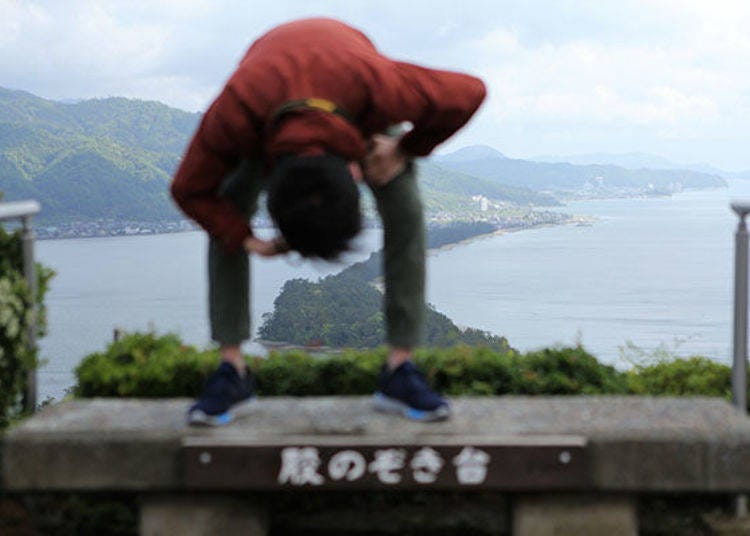
When you look at the scenery upside down through your legs, it appears as if the pine grove is Heaven. The boundary between the sea and sky is gone, and Amanohashidate looks like a dragon soaring through the sky, giving it the nickname "Flying Dragon."

Here is Amanohashidate as seen from an under-the-legs shot. Can you see the dragon dancing in the sky? This particular day was pretty cloudy, so it may not be as clear, but if you come back on a clear day, you can surely see the powerful dragon emerge.

Near the observation deck was a "kawarake throw" area. It is a custom offering prayer and protection from misfortune, and has been performed in Japan since long, long ago.

You throw the kawarake through the "ring of wisdom" set about 5 to 6m away. I hope that my wishes will come true if I can get even one through the ring. I aim at the target, and... YES!! It was quite difficult, but I was able to get in one of my three throws!
Along with the observation deck and kawarake throw, there is also a Ferris wheel, cycle cars, a shooting range, and a cafe, so you can enjoy it as an amusement park as well. Also recommended for families with small children.

I return to the bottom of the mountain via lift. If you were to use the lift in only one direction, I recommended using it on the way down, because it faces directly towards Amanohashidate. You can take some great photos as you descend the mountain in an open-air lift.
-
Amanohashidate View Land天橋立ビューランド
- Address 437 Monju, Miyazu-shi, Kyoto-fu
- Phone Number 0772-22-1000
Hours: February 21st - July 20th / 9:00AM - 5:00PM, July 21st - August 20th / 8:30AM - 6:00PM, August 21st - October 20th / 9:00AM~5:00PM, October 21st~February 20th/9:00AM~4:30PM
Closed: N/A
Biking through the 3.6km pine forest road

Amanohashidate is not just a good place to view from mountaintop, but a place you can actually walk and bicycle through as well. After coming down by lift, I decided to cross from south to north.
On the south side are many souvenir shops and restaurants, as well as Chionji Temple (Monjudo), famous for the proverb "sannin yoreba monju no chie," (literally "three people together produces the wisdom of Monju, god of wisdom" and the Japanese equivalent of "two heads are better than one.")
The above photo is a rotating bridge close to Monjudo. It rotates about 90 degrees in order to let ships pass through.

Amanohashidate is about 3.6 km in length and takes about 50 minutes to walk on foot. Because it would take up time (and physical strength) I decided to rent a bicycle to ride there, and buy a boat ticket for the ride back. Now let's go for a bike ride in Amanohashidate!
-
Amanohashidate Tourist Boat & Rental Cycle天橋立観光船&レンタサイクル
- Address 466 Monju, Miyazu-shi, Kyoto-fu (Passenger ship sales area)
- Phone Number 0772-22-2164
Hours: 8:30AM~5:30PM
Closed: N/A
Fees: Sightseeing boat & rental cycle ¥900 including tax (2 hrs limit for rental cycle. May be dropped off at sightseeing boat on the north side.)
0772-22-2164
(Tango Kairiku Kotsu Co., Ltd., Passenger Ship Sales Office)
Hashidate Chaya: Enjoying Amanohashidate's local specialty

Across the bridge I found a little teahouse, just as I was beginning to notice my stomach grumbling, I decided to stop by for lunch before my workout. I visited Hashidate Teahouse, and decided to try their 'Specialty Asari-Don' (clam rice bowl), as seen on the signboard.
"Amanohashidate has been long known for their clams, and you can get clams here just about any time except winter," explains the hostess. Well then I just have to order it! "One Asari-Don Please!"

I waited for a while.
My dish arrives, and it is served with plenty of clams! I don't think I have ever seen this many clams together in one dish, so I was pretty excited. It seems many clams are all boiled together in a large pot, and served with plenty of soup. Time to dig in!
Mmm... such a fine taste. I can tell that many flavorful ingredients were used in the broth. The clams were plump, crisp, and delicious. Even the Koshihikari, rice produced locally here in Kyotango, was sweet. At this pace, I could finish 2 cups in no time. This set was the perfect light lunch for anyone who loves shellfish, especially clams.
-
Hashidate Chayaはしだて茶屋
- Address Monju, Miyazu, Kyoto Prefecture (Inside Amanohashidate Park)
- Phone Number 0772-22-3363
Hours: 7:30AM~5:00PM
Closed: Thursdays (no closings during summer)

Once I filled my stomach, I felt rejuvenated and ready for cycling. Lush pine trees line both sides of the road. There is no other scenery quite like these lines of pine trees, seemingly floating in the ocean. It must be why this spot has been adored by people since long ago.

Amanohashidate Shrine

About one-third of the way along the path, I found a small shrine, which according to the guidebook was the Amanohashidate Shrine. With a long history, it is said that it was built as a guardian of Chionji Monju Temple from the end of the Heian Period to the Kamakura Period. Also famous as a power spot, it seems many women also visit in the hopes of granting their wishes of love.
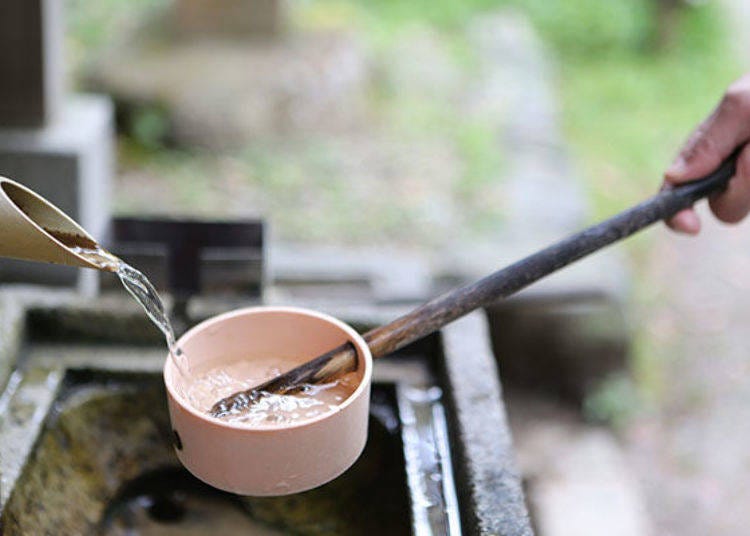
Isoshimizu, a small well next to the shrine. While Amanohashidate is surrounded by seawater, the water here is fresh and contains no salt. It is also used as 'chozu' (water for cleansing), so I will purify myself before entering the shrine.


The east side of the footpath is a sandy beach. In the summer, it is a popular swimming spot for tourists.
A white sandy beach and thick, green pine trees. 'Hakushaseisho' is a word that is used to describe the beautiful scenery of Amanohashidate (a word that means a 'beautiful stretch of sandy beach dotted with pine trees'). When left untreated, pine trees can become a broadleaf forest through the natural development of the ecosystem, so conservation activities such as removal of dead trees and undergrowth have been carefully maintained since long ago. The reason we can see such beautiful scenery today is thanks to the efforts of many people, from past to present.
There's just a little more of this foot path left, so let's continue!
Motoise Kono Shrine: One of Japan's leading histories, the Land of Myths

After crossing Amanohashidate and cycling from the north for another 3 minutes, you come to a large torii gate. This is Motoise Kono Shrine. Though founded during the Nara Period, it is thought to be much older, dating back to as far as the Kamiya Period.
Though it once enshrined deity Amaterasu Omikami, following the story, her enshrinement was transferred to Ise by deity Toyoke-no-Omikami, hence why it is now called "Moto-Ise," or "former Ise," shrine. It is also sometimes called "Ise-Jingu no Furusato," or "Home of the Ise Jingu Shrine." This shrine is one of the most famous shrines in Japan, boasting the titles of "Tango no Kuni Ichinomiya" in the Nara Period, and "Myojin Taisha" in the Heian Period, both being titles that reflect high rank and important status. Now let's pay our respects at the shrine.


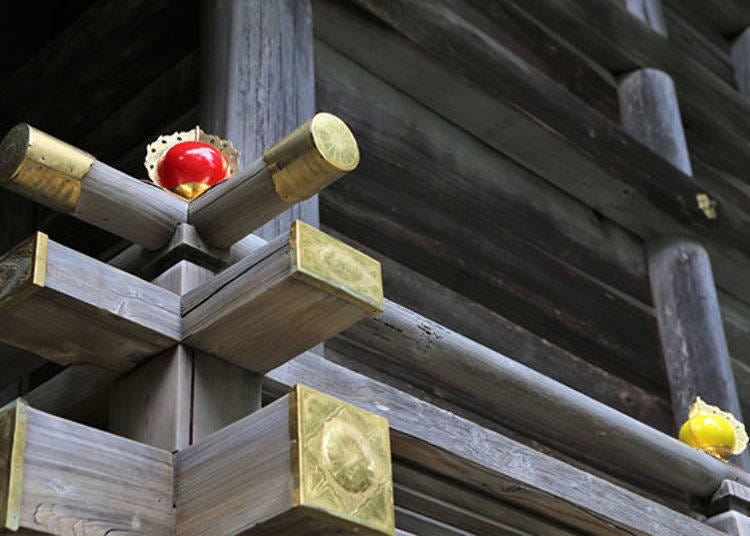
At the main shrine, you can see the "Goshiki no Suetama," or the Five-colored Suetama (sitting balls). You can see the suetama in their five different colors of blue, red, yellow, white and black from the hall, emitting a mysterious light. They are very special and precious objects that can only be found at Ise Shrine and Moto-Ise Shrine. It is based on Chinese philosophy and said to represent the five elements, wood (blue), fire (red), earth (yellow), gold (white), and water (black) of which all things are made of.

The main shrine features the same architectural structure as Ise Shrine, called 'yuiitsu-shinmei-zukuri.' It is characterized by a large pillar that supports both ends of the ridge beams. There seems to be another large supporting pillar in the center of the main shrine.
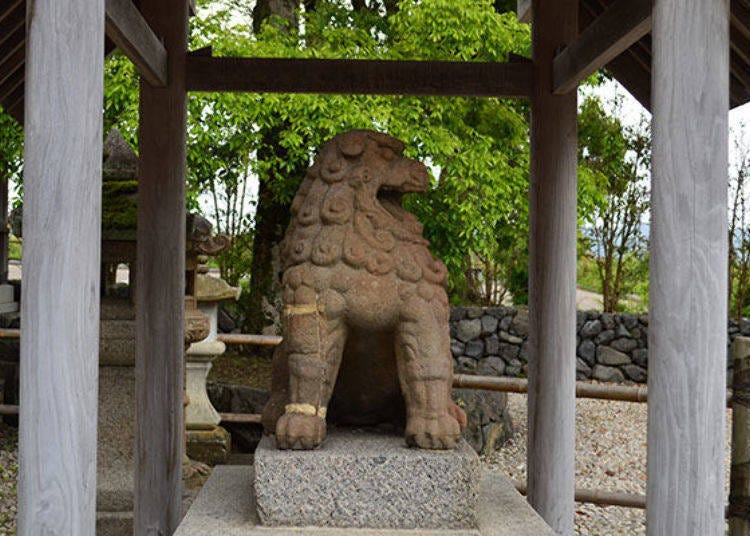
This statue is of a komainu, or guardian lion-dog, and is designated as an Important Cultural Property. If you look closely, you can see traces that look like cuts made with a sword on the right leg. Legend says that these guardian dogs used to run rampant around Amanohashidate and attack the passersby, until one day the hero of the story came and slay them with a single slash of his sword. Since then, they turned into stone, and remain here as protectors of the land in the form of these statues.
"The inner shrine is located about 10 minutes on foot from here," says Umemoto. It is said that the shrine, which was a place of worship before being transferred in the Nara Period, was called "Manai Shrine." This is the shrine that became the Amanohashidate legend, so of course, I must go see it! I head to the holy shrine.
-

-
Address
430, Ogaki, Miyazu-shi, Kyoto, 629-2242
View Map -
Nearest Station
Amanohashidate Station (Tantetsu Miyatoyo Line)
30 minutes by bus
- Phone Number 0772-27-0006
-
Address
430, Ogaki, Miyazu-shi, Kyoto, 629-2242
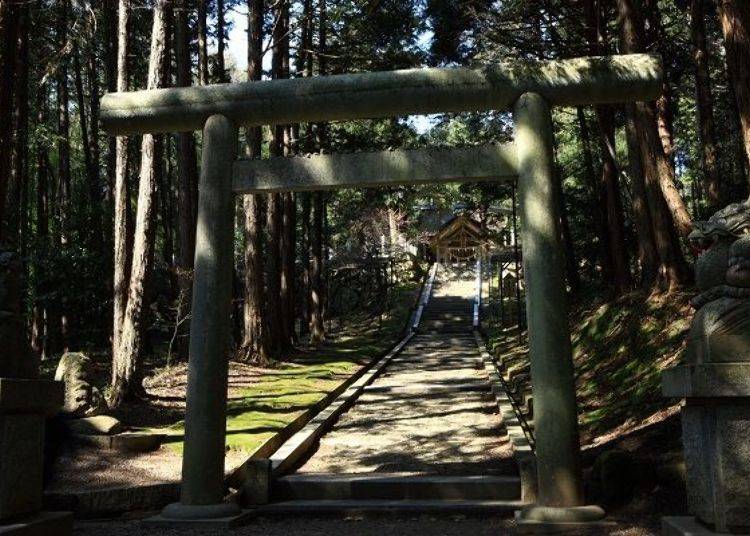
In mythological times, Manai Shrine is where the great deity Toyoke was worshipped. Amaterasu Omikami was transferred there from the country of Yamato. The story goes that though both deities were worshipped here together for four years, until Toyoke was moved to Ise. This is why now, Amaterasu Omikami is worshipped in the inner shrine, and Toyoke is enshrined in the outer shrine of the Ise Shrine.

In the inner shrine of this main shrine is also the place that became the origin of the Amanohashidate legend of Izanagi and Izanami, as a place where the gods descended. It is a very sacred space that has remained unchanged for the last 2,500 years. Also, the water springs called "Ama-no-Manai no Mizu" (Water of Heaven) is visited by many worshippers as a power spot.
This place dedicated to the deities Amaterasu Omikami, Toyoke, and Izanagi and Izanami, is exactly what you would expect of the birthplace of legends. Wrapped in silence with sunrays shining through, it was filled with the atmosphere of a sacred space.
-
Manai Shrine眞名井神社
- Address 86 Koaza Morooka, Ogaki, Miyazu-shi, Kyoto-fu
- Phone Number 0772-27-0006
Free Entry
0772-27-0006 (Kono-Ise Shrine Office)
Kasamatsu Park: To one more scenery spot

After my shrine visit, I passed through the gate front town of Moto-Ise Kono Shrine and headed to the cable car stop. In the souvenir shop I found many specialty local products such as dried fish, black chikuwa (fish cakes), and black beans.


Kasamatsu Park is a viewpoint located on a high mountain top, from which you can look out over the scenery from the northern point of Amanohashidate. You can get to the top via cable car or lift. The cable car runs every 15 min with a travel time of 4 minutes, and the lift is operated continuously with a travel time of 6 minutes. Admission fee is ¥330 one way and ¥660 round trip. Children are ¥170 one way and ¥330 round trip (tax included).

I arrived at the top in no time. The view from Kasamatsu Park is called "Shoryukan," or "view of dragons," and is said to depict a dragon rising to Heaven.

Another photo shot through the legs. What does the landscape look like to you?


There is a Kawarake Throw in Kasamatsu Park, just like there was at Amanohashidate View Land. Here they cost ¥200 for three (tax included). I decide to challenge this one as well. I only got one in last time, so how would I fare this time around?
Too bad... this time, I wasn't even able to get one in!
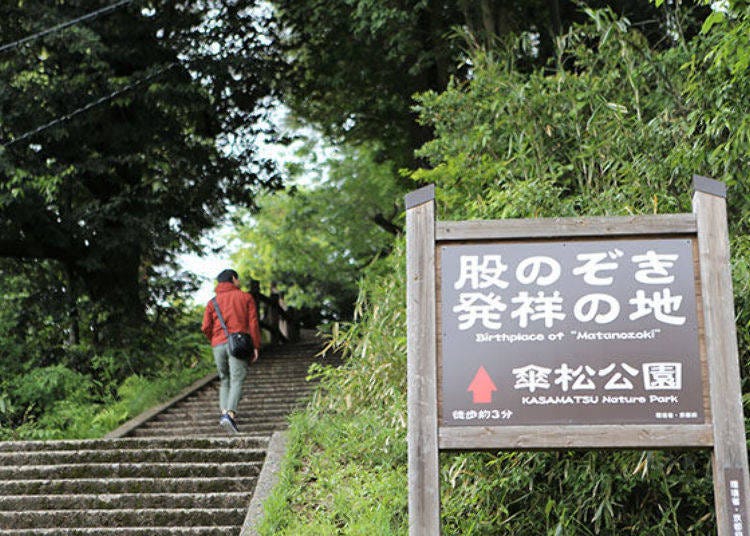
I saw a signboard that read, "the birthplace of the ['through-the-legs'] shot." When I asked the staff in the cable car station, it seems the place up the stairs about 3 minutes away has been a popular spot for taking through-the-legs shots for a long time. Though my legs were already crying out in pain from the cycling, I did my best...


What do you think? Does it seem that changing the angle and looking from a higher point than the observation deck makes it look more like a dragon?
There are take-out cafes and restaurants around the cable car station where you can enjoy a well-deserved break after enjoying the spectacular views.

-
Kasamatsu Park (Cable Car)傘松公園(ケーブルカー)
- Address Ogaki, Miyazu-shi, Kyoto-fu
- Phone Number 0772-27-0032
Hours: 8:00AM~5:30PM (January/February: until 4:30PM, March/November: until 5:00PM, July 20 - August 20: until 6:00PM)
Closed: N/A
Fee: Adult one-way ¥330, round-trip ¥660 / children one-way ¥170, round-trip ¥330 (tax included)
0772-27-0032
(Tango Kairiku Kotsu Co., Ltd. Sales Office)

It was a long run, but the Amanohashidate and Power Spot Tour has come to an end. I finally leave behind the rental cycle at the sightseeing boat, and take the pleasure boat from the northern shore of Amanohashidate to the south shore. While looking back at the pine forests left behind in my travels, I already fondly recall my trip.
The course introduced today takes about a half-day to get through. If you come to the Tango region, by all means do try it out for yourself. By visiting the Amanohashidate area, you will be sure to see some of the most spectacular landscapes and power spots in Japan.
Book an unforgettable experience in Amanohashidate!
Make your trip extra memorable by booking one of these recommended tours on our partner site, Rakuten Travel Experiences!
- Area
- Category
*Prices and options mentioned are subject to change.
*Unless stated otherwise, all prices include tax.
Popular Tours & Activitiess
Recommended places for you
-

ISHIDAYA Hanare
Yakiniku
Kobe, Sannomiya, Kitano
-

Jukuseiniku-to Namamottsuarera Nikubaru Italian Nikutaria Sannomiya
Izakaya
Kobe, Sannomiya, Kitano
-

Kambei Sannomiyahonten
Yakiniku
Kobe, Sannomiya, Kitano
-

Sunflower terminal (Osaka) Terminal 1
Other Sightseeing
USJ, Nanko Port
-

Kanzenkoshitsuyakinikutabehodai Gyugyu Paradise Sannomiya
Yakiniku
Kobe, Sannomiya, Kitano
-
Goods

Yoshida Gennojo-Roho Kyoto Buddhist Altars
Gift Shops
Nijo Castle, Kyoto Imperial Palace
-

New Way to Reach Koyasan! Ride Nankai's 'GRAN Tenku' for a Heavenly Journey
by: Guest Contributor
-
Ad

Experiencing Manga as Culture, Not Just Reading It: Expo 2025 with Rumiko Takahashi
-

Celebrate a Dreamy Barbapapa Christmas at JR Osaka Station's Twilight
by: Guest Contributor
-

November Events in Kansai: Fun Festivals, Food, and Things to Do in Kyoto & Osaka
-
Ad

Café Bahnhof in Osaka: The home-roasted coffee that captivated G20 leaders!
-

Kyoto's Hidden Treasures Open This Winter! Enjoy Exclusive Access to 15 Rare Cultural Sites (Jan-Mar 2026)
by: Guest Contributor
Inspiration for Accommodations
-

Spacious Family Hotel in Namba: 20 Comfortable Stays for Family Fun
-

Charming Hotels to Enjoy the Spectacular Views of Arashiyama's Autumn Leaves from Your Room
-

Experience Stunning Views of Osaka Castle from Private Spaces: Top Hotels Near Osaka Castle
-

Recommended by Visitors! Arashiyama's Best-Rated Hotels
-

Family-Friendly Universal Studios Japan Hotel with Excellent Access
-

Enjoy a Comfortable Stay in Osaka! 10 Hotels with Convenient Airport Shuttle Services
-

Top 10 Recommended Hotels Near Namba Station with Great Access
-

Enjoy Night Views from Your Room! Recommended Hotels in Namba Area
-

‘Why Am I So Sweaty?!’ 5 Ways Japanese People Cool Down in Osaka’s Sweltering Summer
-

5 Popular Shops and Gift Ideas Along Arashiyama Shopping Street
-

Introducing Kyoto: Japan’s Ancient Capital and Spiritual Homeland!
by: Steve Csorgo
-

5 Popular Things to do in Umeda - Osaka's Central Area!
by: WESTPLAN
-

Inside Kobe Tower: Fun Things to Do at the Symbol of Kobe
-

Osaka Travel Service Center: So Many Incredibly Convenient Services - in English!
by: WESTPLAN
- #best gourmet Osaka
- #things to do Osaka
- #what to do in kyoto
- #what to bring to japan
- #best gourmet Kyoto
- #new years in Osaka
- #what to buy in nanba
- #Visiting Osaka
- #onsen tattoo friendly arima
- #daiso
- #Visiting Kyoto
- #best japanese soft drinks
- #japanese fashion culture
- #japanese convenience store snacks
- #japanese nail trends













